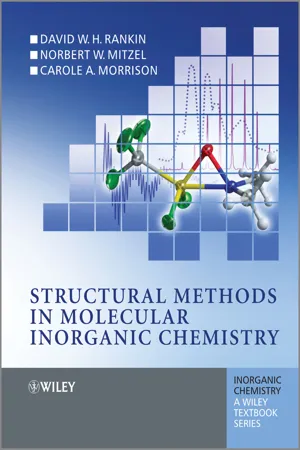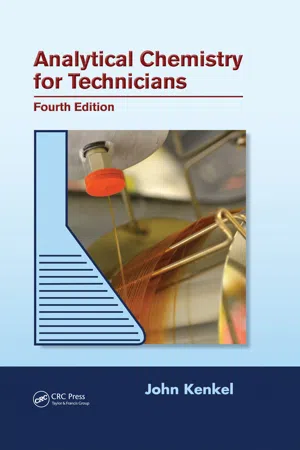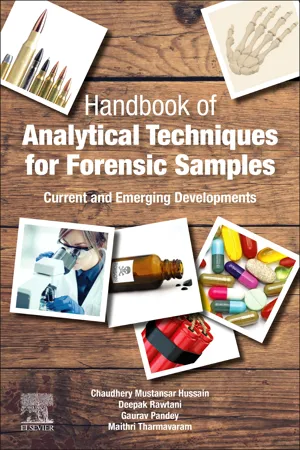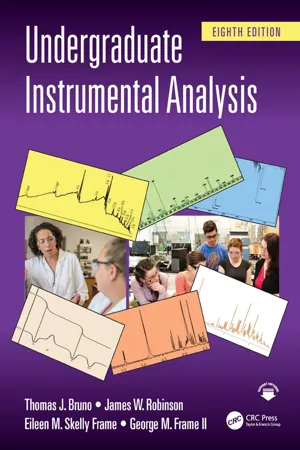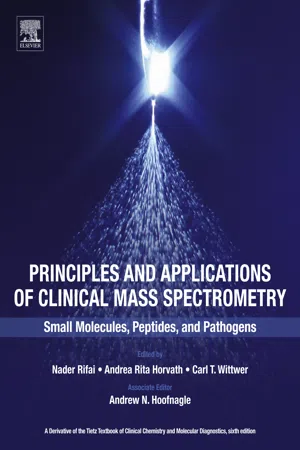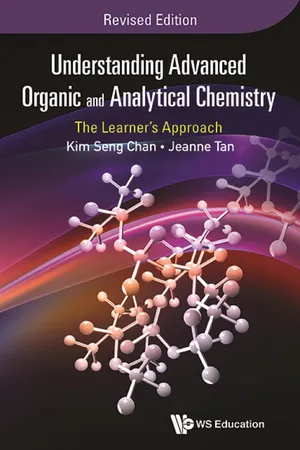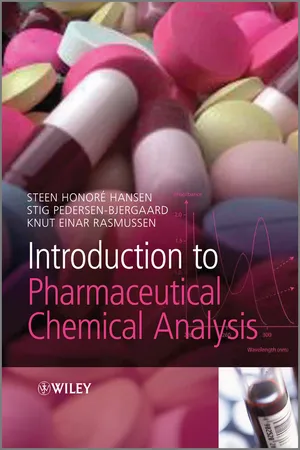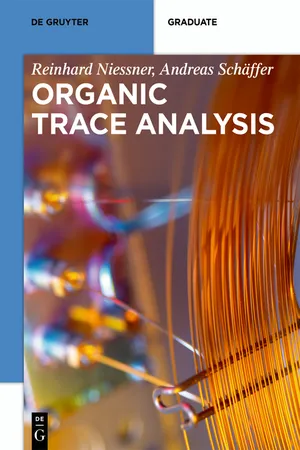Chemistry
Mass Spectrometer
A mass spectrometer is an analytical instrument used to measure the mass-to-charge ratio of ions. It works by ionizing chemical compounds and then separating the ions based on their mass. This allows for the identification of the chemical composition and structure of the sample.
Written by Perlego with AI-assistance
Related key terms
Related key terms
1 of 4
Related key terms
1 of 3
9 Key excerpts on "Mass Spectrometer"
- D. W. H. Rankin, Norbert Mitzel, Carole Morrison(Authors)
- 2013(Publication Date)
- Wiley(Publisher)
11 Mass Spectrometry 11.1 Introduction A Mass Spectrometer is an instrument in which gaseous ions are produced from a sample, separated according to their mass-to-charge ratios (m / z) using electric and/or magnetic fields, and then detected in terms of their abundance. Thus, a spectrometer is in principle very simple, consisting of an ion source, a mass analyzer and a detector. Of course, in practice there are many variations on this basic theme, and a high-resolution Mass Spectrometer is a sophisticated and expensive device. In this book, we can only consider the principles of operation very briefly; for full details, standard texts should be consulted. References [1] and [2] have good, up-to-date accounts of mass spectrometry (MS), and [3] and [4] are reviews that include many references to applications of the technique in inorganic chemistry. One of the most useful pieces of information that can be provided by a standard Mass Spectrometer is the molecular mass of a compound with an accuracy of 1 dalton (Da) (1 Da = 1 unified atomic mass unit (u) = 1.660538921(73) × 10 −27 kg). Even better, high-resolution mass spectrometry can provide us with accurate molecular masses, which are accurate to about 10 −4 Da, depending on the total resolution of the spectrometer. At this level the atomic masses deviate substantially from multiples of 1 Da, e.g. is 12.0000 Da by definition, but the mass of isotope is 15.9949 Da (not 16), and that of is 14.0031 Da (not 14). This sensitivity can be used to work out the elemental composition or, more critically, the isotopic distribution of atoms in a molecule, which can help to identify unknown compounds. And since the basic experimental procedure involves supplying a particular quantity of energy to a molecule or ion to cause it to fragment, we can use it to deduce compound gas-phase stabilization energies, which can be further substantiated by computational modeling- eBook - ePub
- John Kenkel(Author)
- 2013(Publication Date)
- CRC Press(Publisher)
13 Mass Spectrometry13.1 Basic Principles
Mass spectrometry is an instrumental analytical technique that provides information about a molecule’s mass. It generates ions from analyte atoms or molecules, separates these ions from each other on the basis of their mass and charge, and then generates an electronic signal for each. The series of sharp peaks, one for each ion, is then displayed as a so-called mass spectrum , which is a plot of the signal vs. mass-to-charge ratio. The magnitude of each signal is proportional to the number of each ion found.Although the technique is named a “spectrometric” or “spectroscopic” technique, and the word “spectrum” is used to describe the data, it does not use light at all. The name likely results from the very early instruments in which photographic plates or phosphor screens were used to detect the ions. Also, the modern instruments use ion detectors that are similar in function to photomultiplier tubes used in spectroscopy, as we shall see in Section 13.4 . One could consider that the ions are separated from each other in a manner that is analogous to how a monochromator functions in separating wavelengths and displaying an absorption spectrum. Instead of scanning wavelengths and developing an absorption signal for each wavelength, many Mass Spectrometer designs scan electric field strength, separate ions based on mass-to-charge ratio, and then produce a signal for each in the mass detector. In any case, the technique is called mass spectrometry; instruments are called Mass Spectrometers; and the data generated are referred to as mass spectra.The mass spectrum consists of a series of sharp peaks resembling vertical lines, each due to an ion of a particular mass-to-charge ratio. The example given in Figure 13.1 is for a very simple molecule, methane, CH4 . The charged formulas indicated there next to each vertical line all result from the fragmentization of methane molecules. The CH3 + and CH4 + - eBook - ePub
Handbook of Analytical Techniques for Forensic Samples
Current and Emerging Developments
- Deepak Rawtani, Gaurav Pandey, Maithri Tharmavaram, Chaudhery Mustansar Hussain(Authors)
- 2020(Publication Date)
- Elsevier(Publisher)
Chapter 16: Mass spectrometry in forensic chemistry
Abstract
Mass spectrometry is a highly advanced technique capable of detecting compounds on the basis of the mass-to-charge ratio of the ions generated from the compounds. This technique is highly sensitive and provides an accurate and reliable estimation of different compounds, especially in the field of forensic science. Apart from providing information regarding molecular weight, it is also capable of providing elemental information as well. In forensic science, it has been used for the analysis of biological samples, the examination of drugs and foods, explosives and gunshot residue analysis, fiber analysis, detection of inks in questionable documents, and the investigation of oil spills and petroleum products. Such applications of mass spectrometry in forensic science along with the theory and instrumentation of this technique are discussed in this chapter.Keywords
Mass spectrometry; Biological samples; Questionable documents; Gunshot residues; Forensic science1: Introduction
Forensic science, especially forensic toxicology, requires appropriate characterization techniques to properly detect compounds with high reliability, accuracy, and validity. In order to achieve this, chromatography techniques are widely used to separate the analytes; they are usually paired with a powerful technique known as mass spectrometry. This technique allows the highly sensitive and accurate determination of a myriad of compounds and provides rich elemental information, even in a mixture of compounds. It also has unparalleled detection limits and speed and thus is highly suitable for the detection of forensic samples such as pesticides, drugs, toxins, and poisons (Maurer, 1998 ; Rawtani et al., 2019 ).Mass Spectrometers target the mass-to-charge ratio of any molecule and detects it on this basis. The theory and principle of Mass Spectrometers will be discussed further in this chapter. It can not only detect the molecules, but can also perform its quantitative detection. This is done through a series of steps that mainly involves the ionization of the molecules, due to which fragmentation occurs that is further detected. In this chapter, the principle, theory, and instrumentation of mass spectrometry are discussed. Also, the applications of the technique in the analysis of various forensic evidence is discussed. - eBook - ePub
- Thomas J. Bruno, James W. Robinson, George M. Frame II, Eileen M. Skelly Frame(Authors)
- 2023(Publication Date)
- CRC Press(Publisher)
CHAPTER 10 Mass Spectrometry I Principles and InstrumentationDOI: 10.1201/9781003188544-10Mass spectrometry (MS) is a technique for creating gas-phase ions (or radical ions) from the molecules or atoms in a sample, separating the ions according to their mass-to-charge ratio, m/z, and measuring the abundance of the ions formed. MS is currently one of the most rapidly advancing fields of instrumental analysis. It has developed from an inorganic method used to prove that most elements exist as isotopes of differing masses to one of the cornerstone techniques used to elucidate the structure of biomolecules, especially high relative molecular mass (RMM) proteins. MS provides the analyst with information as diverse as the structure of complex organic and biomolecules to the quantitative determination of ppb concentrations of elements and molecules in samples.MS is an analytical technique that provides qualitative and quantitative information, including the mass of molecules and atoms in samples as well as the molecular structure of organic and inorganic compounds. MS can be used as a qualitative analytical tool to identify and characterize different materials of interest to the chemist or biochemist. MS is used routinely for the quantitative analysis of mixtures of gases, liquids, and solids. MS is used in many fields in addition to identifying and quantifying organic and biological molecules. These include atomic physics, physical chemistry, and geology.This chapter will focus on MS principles and instrumentation for both organic and inorganic analysis. Chapter 11 will cover applications of MS for organic and inorganic analyses as well as interpretation of simple mass spectra for structural identification of organic compounds.10.1 PRINCIPLES OF MS
The Mass Spectrometer is an instrument that separates gas-phase ionized atoms, molecules, and fragments of molecules by the difference in their mass-to-charge ratios. The mass-to-charge ratio is symbolized by m/z, where the mass m is expressed in unified atomic mass units and z is the number of charges on the ion. The statement found in many texts that MS separates ions based on mass is only true when the charge on the ion is a single + or −; in this case, m/z - eBook - ePub
Principles and Applications of Clinical Mass Spectrometry
Small Molecules, Peptides, and Pathogens
- Nader Rifai, A. Rita Horvath, Carl T. Wittwer, Andy Hoofnagle(Authors)
- 2018(Publication Date)
- Elsevier(Publisher)
2Mass Spectrometry
Alan L. Rockwood, Mark M. Kushnir, and Nigel J. Clarke∗Abstract
BackgroundMass spectrometry is a powerful analytical technique used to identify and quantify analytes using the mass-to-charge ratio (m/z) of ions generated from a sample. It is useful for the analysis of a wide range of clinically relevant analytes, including small molecules, proteins, and peptides. When mass spectrometry is coupled with either gas or liquid chromatographs, the resultant analyzers have expanded analytical capabilities with widespread clinical applications, including quantitation of analytes from myriad body tissues and fluids. In addition, because of its ability to identify and quantify proteins, mass spectrometry is widely used in the field of proteomics.ContentThis chapter describes the basic concepts and definitions of mass spectrometry. Techniques based on mass spectrometry require an ionization step wherein an ion is produced from neutral atoms or molecules. Electron impact and chemical ionization (CI) are often used in gas chromatography–mass spectrometry. In liquid chromatography–mass spectrometry, electrospray ionization (ESI) and atmospheric pressure CI are the most commonly used techniques. In microbiology, a desorption/ionization technique termed MALDI (matrix-assisted laser desorption ionization) is employed. Each of these ionization techniques is described in detail, and advantages of the techniques are highlighted. Once molecules are ionized, resultant ions are analyzed using either beam type analyzers (eg, quadrupole, or time-of-flight [TOF]) or trapping mass analyzers (eg, ion trap). Mass analyzers also can be combined to form tandem Mass Spectrometers, which allow further expending capabilities of the technique. Clinical applications of mass spectrometry are provided to illustrate the role of this technique in the analysis of clinically relevant analytes. - eBook - ePub
Understanding Advanced Organic and Analytical Chemistry
The Learner's ApproachRevised Edition
- Kim Seng Chan, Jeanne Tan;;;(Authors)
- 2016(Publication Date)
- WS EDUCATION(Publisher)
CHAPTER 14
Mass Spectrometry
14.1 Introduction
Mass spectrometry is an analytical technique that enables us to determine the chemical composition of a sample and elucidate the structures of compounds based on the mass-to-charge ratio of charged particles.The fundamental principle lies in the fact that charged particles of different mass and charge behave differently in an electric or magnetic field. If we have a beam of positively charged particles moving across an electric field, it will deviate from its original path and get deflected towards the negative plate. If the beam is comprised of negatively charged particles, it will deflect towards the positive plate. All this is in accordance with the concept of like charges repel and unlike charges attract.An atom is electrically neutral since it contains equal numbers of protons and electrons. A beam of atoms moving across an electric field will continue in its path and not be deflected at all. Molecules made up of atoms are also neutral species, so how can we use this technique to identify molecules? We can actually transform these neutral species into positively charged particles through the process known as ionization. Electrons are forcefully removed from atoms (even those which tend to form anions), which makes ionization an energetically demanding but possible process.If a sample containing different molecules is ionized into positively charged species, how do we identify them if they deflect towards the same negative plate? These like charges are differentiated by the amount of deviation from their trajectory, defined as the angle of deflection (θ):The positively charged species with the higher charge experiences greater attractive force exerted by the negative plate and deviates more from its trajectory. For two ions of the same unit charge but different masses travelling at the same speed, the heavier particle has a greater kinetic energy (K.E. = 1/2 mv2 - eBook - ePub
- Steen Honoré Hansen, Stig Pedersen-Bjergaard, Knut Rasmussen(Authors)
- 2011(Publication Date)
- Wiley(Publisher)
Chapter 16 Mass Spectrometry16.1 IntroductionThis chapter discusses the principles of identification and quantitative analysis based on mass spectrometry (MS). MS is an official technique in the European Pharmacopoeia (Ph.Eur.). MS is mainly used for the analysis of drug substances in biological samples. Various MS techniques will be reviewed, and the most widely used instrumentation will be discussed. Applications of MS are presented in Chapter 23 in connection with the bioanalysis of drug substances.Mass spectrometry is performed using a relatively expensive and sophisticated instrument called a Mass Spectrometer (MS). The MS is normally coupled to either gas chromatography (GC-MS) or liquid chromatography (LC-MS). In the case of GC-MS, the analytes (drug substances and other organic compounds) are bombarded with electrons in a vacuum inside the Mass Spectrometer. Initially, this leads to some of the molecules being ionized either to positive ions (molecules lose an electron) or negative ions (molecules take up an electron). These ions are called molecular ions . The mass of an molecular ion is equivalent to the mass of the original molecule because the weight of an electron that is either lost or taken up is incredibly small. In some cases, molecular ions are unstable and very quickly split into smaller fragments as chemical bonds in the molecules are broken. This process is called fragmentation . Some of the fragments remain ionized (fragment ions ), while others lose their charge. Figure 16.1 shows an example of how ionization and fragmentation can take place. When chlorambucil (antineoplastic drug) is bombarded with electrons in the Mass Spectrometer, some of the molecules ionize to the positively charged molecular ions with mass 303. A large proportion of these are unstable and will fragment. Fragmentation of chlorambucil occurs due to several reactions, but only one of them is discussed at this stage. The dominating process is the cleavage of CH2 Cl from the molecular ion. The weight of CH2 - eBook - ePub
- Reinhard Nießner, Andreas Schäffer(Authors)
- 2017(Publication Date)
- De Gruyter(Publisher)
9Mass Spectrometry9.1Introduction
Mass spectrometry (MS) is certainly the highest performer and best service provider among the detection techniques, combined with chromatography or other separation schemes. Briefly spoken, MS makes use of the determination of electrical mobility of charged species within an electromagnetic field, thus representing an orthogonal separation technique to chromatography (i.e., two essentially different methods used to separate the same analyte). Hyphenation of both generates extremely high resolutions in separating complex samples, required for example in crude oil analysis, protein characterization or nontargeted analysis within the fields of -omic techniques [1 ].Already 100 years ago, Dempster and Aston (1918/1919) were forerunners of the modern MS technology, after Thompson (1911) had detected the separation of gas ions within an electric field. Furthermore, tremendous technical advances were achieved during World War II, when huge sector-field MS instruments were built and run in parallel for preparative uranium isotope fractionation (“Manhattan project”). With the advent of various energy-selective and intensity-adapted ionization techniques (e.g., by laser, radiation from radioactive decay, inductively coupled plasma, collision-rated ionization or thermal surface interaction, etc.), the applications became numerous [2 ].Nowadays, MS is (beyond the still applied isotope fractionation) mainly used for separation and identification of larger organic molecules (up to >100 kDa), derived from environment, industry and life sciences. In contrast to the first very bulky and heavy versions (due to huge magnets and vacuum pumping), nowadays table-top instrumentation with high-resolution capabilities is available, and miniaturized instruments are already a permanent part of space missions for extraterrestrial research [3 - Jeroen Kool, Wilfried M. A. Niessen, Jeroen Kool, Wilfried M. A. Niessen(Authors)
- 2015(Publication Date)
- Wiley-VCH(Publisher)
1 Introduction to Mass Spectrometry, a TutorialWilfried M.A. Niessen and David Falck1.1 Introduction
In the past 30 years, mass spectrometry (MS) has undergone a spectacular development, in terms of both its technological innovation and its extent of application. On-line liquid chromatography–mass spectrometry (LC–MS) has become a routine analytical tool, important in many application areas. The introduction of electrospray ionization (ESI) and matrix-assisted laser desorption/ionization (MALDI) has enabled the MS analysis of highly polar and large molecules, including biomacromolecules. MS is based on the generation of gas-phase analyte ions, the separation of these ions according to their mass-to-charge ratio (m/z), and the detection of these ions. A wide variety of ionization techniques are available to generate analyte ions (Section 1.3). Mass analysis can be performed by six types of mass analyzers (Section 1.4), although quite frequently tandem Mass Spectrometers, featuring the combination of two mass analyzers, are used (Section 1.5). The data acquired by MS allow quantitative analysis of target analytes, determination of the molecular mass/weight, and/or structure elucidation or sequence determination of (unknown) analytes (Section 1.6).This chapter provides a general introduction to MS, mainly from a functional point of view. Next to basic understanding of operating principles of ionization techniques and mass analyzers, the focus is on data interpretation and analytical strategies required in the study of biomolecular interactions using MS.1.2 Figures of Merit
1.2.1 Introduction
An MS experiment typically consists of five steps: (i) sample introduction, (ii) analyte ionization, (iii) mass analysis, (iv) ion detection, and (v) data processing and interpretation of the results. Sample introduction may involve individual samples or may follow (on-line) chromatographic separation. Mass analysis and ion detection require a high vacuum (pressure ≤ 10−5
Index pages curate the most relevant extracts from our library of academic textbooks. They’ve been created using an in-house natural language model (NLM), each adding context and meaning to key research topics.
Explore more topic indexes
Explore more topic indexes
1 of 6
Explore more topic indexes
1 of 4
